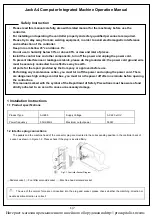
OPERATION
8200D 330080 (1--98)
36
SWEEPING, SCRUBBING, AND BRUSH
INFORMATION
Pick up oversized debris before sweeping. Flatten
or remove bulky cartons from aisles before
sweeping. Pick up pieces of wire, twine, string, or
anything that could become entangled in the
brush or brush plugs.
Plan the sweeping and scrubbing in advance. Try
to arrange long runs with minimum stopping and
starting. Sweep debris from very narrow aisles
into main aisles ahead of time. Do an entire floor
or section at one time. Drive as straight as
possible. Overlap the brush paths. Avoid bumping
into posts or scraping the sides of the machine.
Avoid turning the steering wheel abruptly, except
in emergencies. The machine is very responsive
to the movement of the steering wheel.
Adjust the machine speed, scrub brush pressure,
and detergent and solution flow as required when
scrubbing. Use the minimum scrub brush
pressure and solution flow for the best scrubbing
results. Machines with the edge clean option have
the ability to scrub against walls and edges.
When the recovery tank is almost full, the
recovery tank full indicator will blink for almost a
minute before the scrubbing system shuts off. The
recovery tank will have to be drained and cleaned.
Refill the solution tank with clean water and
detergent and continue cleaning.
For best results, use the correct brush type for
your sweeping and scrubbing application. The
following are recommendations for main
sweeping, scrubbing, and side brush applications.
Polypropylene 8-double row main sweep
brush
-- Superior pick-up of sand, gravel, and
paper litter. Polypropylene retains its stiffness
when wet, and can be used indoors or out with
equal performance. Not recommended for
high-temperature debris.
Polypropylene and Wire 8-double row main
sweep brush
-- The wire bristles loosen slightly
packed soilage and heavier debris. The
polypropylene bristles sweep up the debris with
excellent hopper loading.
















































